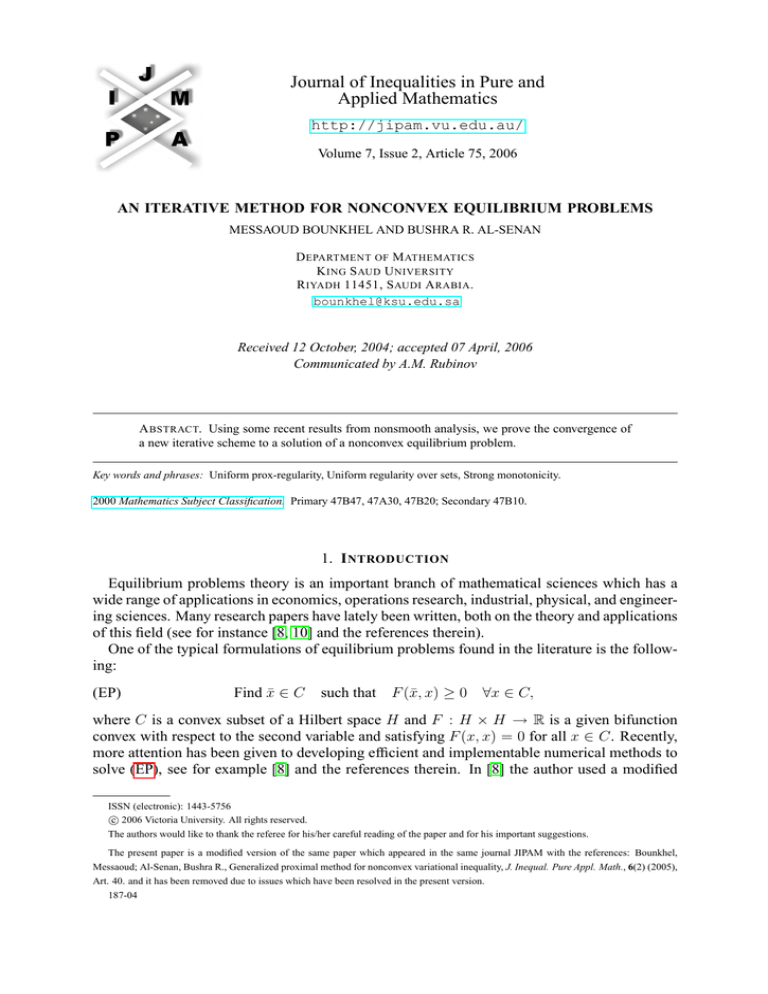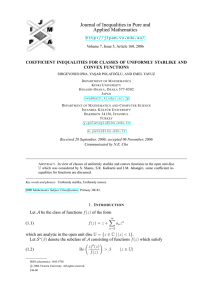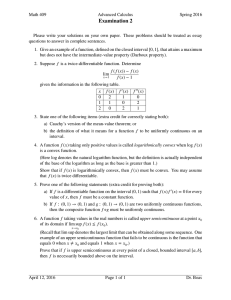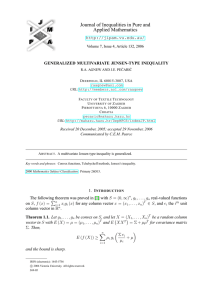
Journal of Inequalities in Pure and
Applied Mathematics
http://jipam.vu.edu.au/
Volume 7, Issue 2, Article 75, 2006
AN ITERATIVE METHOD FOR NONCONVEX EQUILIBRIUM PROBLEMS
MESSAOUD BOUNKHEL AND BUSHRA R. AL-SENAN
D EPARTMENT OF M ATHEMATICS
K ING S AUD U NIVERSITY
R IYADH 11451, S AUDI A RABIA .
bounkhel@ksu.edu.sa
Received 12 October, 2004; accepted 07 April, 2006
Communicated by A.M. Rubinov
A BSTRACT. Using some recent results from nonsmooth analysis, we prove the convergence of
a new iterative scheme to a solution of a nonconvex equilibrium problem.
Key words and phrases: Uniform prox-regularity, Uniform regularity over sets, Strong monotonicity.
2000 Mathematics Subject Classification. Primary 47B47, 47A30, 47B20; Secondary 47B10.
1. I NTRODUCTION
Equilibrium problems theory is an important branch of mathematical sciences which has a
wide range of applications in economics, operations research, industrial, physical, and engineering sciences. Many research papers have lately been written, both on the theory and applications
of this field (see for instance [8, 10] and the references therein).
One of the typical formulations of equilibrium problems found in the literature is the following:
(EP)
Find x̄ ∈ C
such that
F (x̄, x) ≥ 0 ∀x ∈ C,
where C is a convex subset of a Hilbert space H and F : H × H → R is a given bifunction
convex with respect to the second variable and satisfying F (x, x) = 0 for all x ∈ C. Recently,
more attention has been given to developing efficient and implementable numerical methods to
solve (EP), see for example [8] and the references therein. In [8] the author used a modified
ISSN (electronic): 1443-5756
c 2006 Victoria University. All rights reserved.
The authors would like to thank the referee for his/her careful reading of the paper and for his important suggestions.
The present paper is a modified version of the same paper which appeared in the same journal JIPAM with the references: Bounkhel,
Messaoud; Al-Senan, Bushra R., Generalized proximal method for nonconvex variational inequality, J. Inequal. Pure Appl. Math., 6(2) (2005),
Art. 40. and it has been removed due to issues which have been resolved in the present version.
187-04
2
M ESSAOUD B OUNKHEL AND B USHRA R. A L - SENAN
proximal method to solve (EP) (see [1]) which generates the sequence {xk+1 } by solving the
subproblem:
(
Find xk+1 ∈ C such that
(SP)
F (xk+1 , x) + λ−1
k hxk+1 − xk , x − xk+1 i ≥ 0 ∀x ∈ C,
for a given λk > 0. In this paper, we will study a nonconvex equilibrium problem, by using some
recent ideas and techniques from nonsmooth analysis theory to overcome the difficulties arising
from the nonconvexity of both C and F . First, we consider the following natural regularization
of (EP):
(GEP)
Find x̄ ∈ C
such that
F (x̄, x) + ρkx − x̄k2 ≥ 0 ∀x ∈ C
for a given ρ ≥ 0, where C is a closed subset of H and F : C × C → R is a given bifunction
satisfying F (x, x) = 0 for all x ∈ C. Note that any (EP) can be written in the form of (GEP)
with ρ = 0.
Problem (GEP) has been denoted in the literature as a uniformly regular equilibrium problem
(see e.g. [10]). It is also interesting to point out that the authors in [10] proved (in Section
3) the convergence of some algorithms in the convex case to a solution of (EP) in the finite
dimensional setting. It has been commented in Section 4 of [10] that a similar technique used
in the convex case can be used for solving the problem (GEP). However, this is just a comment
at the end of the paper [10], with no further explanations.
Let us propose the following appropriate reformulation of the subproblem (SP):
(
Select xk+1 ∈ C such that xk+1 ∈ xk + M λk B and
(GSP)
xk −xk+1
∈ ∂ p F (xk+1 , ·)(xk+1 ) + NCp (xk+1 ),
λk
where M > 0 is a given positive number. Here ∂ p (resp. N p ) stands for the proximal subdifferential (resp. proximal normal cone). Under natural assumptions, we will prove the convergence
of a subsequence of the sequence {xk } generated by (GSP) to a solution of (GEP).
This paper is organized as follows. In Section 2, we recall some definitions and results that
will be needed in the paper. In Section 3, we prove the main results of this paper. First, we
prove, in Proposition 3.1, that (GSP) is equivalent to (SP) whenever C is a convex subset and
F (x, ·) is a convex function for all x ∈ C. In Proposition 3.2, we prove under the uniformprox-regularity of the set C and the uniform-regularity of the bifunction F with respect to the
second variable (see Definition 2.2 below), that the sequence {xk } generated by (GSP) satisfies
some variational inequality. This result is used to prove, in Theorem 3.3, the convergence of a
subsequence of the sequence {xk } to a solution of (GEP), under natural hypotheses and when
the set of solutions of (GEP) is assumed to be nonempty.
2. P RELIMINARIES
Throughout the paper H will denote a Hilbert space. We recall some notation and definitions
that will be used in the paper. Let f : H → R ∪ {+∞} be a function and x any point in H
where f is finite. We recall that the proximal subdifferential ∂ p f (x) is the set of all ξ ∈ H for
which there exist δ, σ > 0 such that for all x0 ∈ x + δB
hξ, x0 − xi ≤ f (x0 ) − f (x) + σkx0 − xk2 .
Here B denotes the closed unit ball centered at the origin of H. Recall now that the proximal
normal cone of S at x is defined by N p (S, x) = ∂ p ψS (x) where ψS denotes the indicator
function of S, i.e., ψS (x0 ) = 0 if x0 ∈ S and +∞ otherwise. Note that (see for instance [11])
for convex functions (resp. convex sets) the proximal subdifferential (resp. proximal normal
J. Inequal. Pure and Appl. Math., 7(2) Art. 75, 2006
http://jipam.vu.edu.au/
A N I TERATIVE M ETHOD FOR N ONCONVEX E QUILIBRIUM P ROBLEMS
3
cone) reduces to the usual subdifferential (resp. usual normal cone) in the sense of convex
analysis.
Definition 2.1. For a given r ∈]0, +∞], a subset C is uniformly prox-regular with respect
to r (we will say uniformly r-prox-regular) (see [7, 12]) if and only if for all x̄ ∈ C and all
0 6= ξ ∈ N P (C; x̄) one has
ξ
1
, x − x̄ ≤ kx − x̄k2 ,
kξk
2r
for all x ∈ C.
We use the convention 1r = 0 for r = +∞. Note that it is not difficult to check that for
r = +∞ the uniform r-prox-regularity of C is equivalent to the convexity of C, which makes
this class of great importance. Recall that the distance function dS (·) associated with a closed
subset S in H is given by dS (x) = inf{kx − yk : y ∈ S} with the convention dS (x) = +∞,
when S is empty.
For concrete examples of uniform prox-regular nonconvex sets, we state the following:
(1) The union of two disjoint intervals [a, b] and [c, d] with c > b is nonconvex but uniformly
r-prox-regular with any 0 < r < c−b
.
2
(2) The finite union of disjoint intervals is nonconvex but uniformly r-prox-regular and the
r depends on the distances between the intervals.
(3) The set
{(x, y) ∈ R2 : max{|x − 1|, |y − 2|} ≤ 1} ∪ {(x, y) ∈ R2 : |x − 4| + |y − 2| ≤ 1}
is not convex but uniformly r-prox-regular with any 0 < r < 21 .
(4) More generally, any finite union of disjoint convex subsets in H is nonconvex but uniformly r-prox-regular and the r depends on the distances between the sets. For more
examples we refer the reader to [6].
The following proposition recalls an important consequence of the uniform prox-regularity
needed in the sequel. For its proof we refer the reader to [6].
Proposition 2.1. Let C be a nonempty closed subset in H and let r ∈]0, +∞]. If the subset C
is uniformly r-prox-regular then for any x ∈ C and any ξ ∈ ∂ p dC (x) one has
2
hξ, x0 − xi ≤ kx0 − xk2 + dC (x0 ),
r
0
0
for all x ∈ H with dC (x ) < r.
The following proposition is needed in the proof of our main results in Section 3. It is due to
Bounkhel and Thibault [5].
Proposition 2.2. Let C be a nonempty closed subset in H and let x ∈ C. Then one has
∂ p dC (x) = NCp (x) ∩ B.
Now we recall the following concept of uniform regularity for functions introduced and studied in [2] for solving nonconvex differential inclusions.
Definition 2.2. Let f : H → R ∪ {+∞} be a l.s.c. function and O ⊂ dom f be a nonempty
open subset. We will say that f is uniformly regular over O with respect to β ≥ 0 (we will also
say β-uniformly regular) if for all x̄ ∈ O and for all ξ ∈ ∂ p f (x̄) one has
hξ, x − x̄i ≤ f (x) − f (x̄) + βkx − x̄k2
J. Inequal. Pure and Appl. Math., 7(2) Art. 75, 2006
∀x ∈ O.
http://jipam.vu.edu.au/
4
M ESSAOUD B OUNKHEL AND B USHRA R. A L - SENAN
We say that f is uniformly regular over a closed set C if there exists an open set O containing
C such that f is uniformly regular over O.
A wide family of functions can be proved to be uniformly regular over sets. We state here
some examples from [2].
(1) Any l.s.c. proper convex function f is uniformly regular over any nonempty subset of
its domain with β = 0.
(2) Any lower-C 2 function f is uniformly regular over any nonempty convex compact subset of its domain. We recall (see [3]) that a function f : O → R is said to be lower-C 2
on an open subset O of H if relative to some neighborhood of each point of O there is
a representation f = g − ρ2 k · k2 , in which g is a finite convex function and ρ ≥ 0. It is
very important to point out that this class of nonconvex functions is equivalent (see for
instance Theorem 10.33 in [11]) in the finite dimensional setting (H = Rn ) to the class
of all functions f : O → R for which on some neighborhood V of each x̄ ∈ O there
exists a representation f (x) = maxt∈T ft (x) in which ft are of C 2 on V and the index
set T is a compact space and ft (x) and ∇ft (x) depend continuously not just on x but
jointly on (t, x) ∈ T × V . As a particular example of lower-C 2 functions in the finite
dimensional setting, one has f (x) = max{f1 (x), . . . , fm (x), } when fi is of class C 2 .
One could think towards dealing with the class of lower-C 2 instead of the class of uniformly
regular functions. The inconvenience of the class of lower-C 2 functions is the need for convexity
and the compactness of the set C to satisfy the inequality in Definition 2.2 which is the exact
property needed in our proofs. However, we can find many functions that are uniformly regular
over nonconvex noncompact sets. To give an example we need to recall the following result by
Bounkhel and Thibault [6].
Theorem 2.3. Let C be a nonempty closed subset in H and let r ∈]0, +∞]. Then C is uniformly
r-prox-regular if and only if the following holds for all x ∈ H; with dC (x) < r; and all
ξ ∈ ∂ p dC (x) one has
8
hξ, x0 − xi ≤
kx0 − xk2 + dC (x0 ) − dC (x),
r − dC (x)
for all x0 ∈ H with dC (x0 ) ≤ r.
From Theorem 2.3 one deduces that for any uniformly r-prox-regular set C (not necessarily
convex nor compact) the distance function dC is uniformly regular over C + (r − r0 )B := {x ∈
H : dC (x) ≤ r − r0 } for every r0 ∈]0, r].
3. M AIN R ESULTS
Now, we are in position to state our first proposition.
Proposition 3.1. If C is a closed convex set and F (x, ·) is a Lipschitz continuous convex function for any x ∈ C, then (GSP) is equivalent to (SP).
Proof. Let xk+1 ∈ C be generated by (GSP), i.e.,
ζk+1 ∈ ∂ p F (xk+1 , ·)(xk+1 ) + NCp (xk+1 ),
with ζk+1 =
xk −xk+1
.
λk
Then there exists ξk+1 ∈ NCp (xk+1 ) such that
ζk+1 − ξk+1 ∈ ∂ p F (xk+1 , ·)(xk+1 ).
By the convexity of F (xk+1 , ·) and the definition of the subdifferential for convex functions we
have
hζk+1 − ξk+1 , x − xk+1 i ≤ F (xk+1 , x) − F (xk+1 , xk+1 ) ∀x ∈ C
J. Inequal. Pure and Appl. Math., 7(2) Art. 75, 2006
http://jipam.vu.edu.au/
A N I TERATIVE M ETHOD FOR N ONCONVEX E QUILIBRIUM P ROBLEMS
5
and so
(3.1)
hζk+1 , x − xk+1 i ≤ F (xk+1 , x) + hξk+1 , x − xk+1 i
∀x ∈ C.
On the other hand, by the convexity of C and by the fact that ξk+1 ∈ NCp (xk+1 ) we get
hξk+1 , x − xk+1 i ≤ 0 ∀x ∈ C.
Combining (3.1) and the last inequality we obtain
F (xk+1 , x) + λ−1
k hxk+1 − xk , x − xk+1 i ≥ 0 ∀x ∈ C.
Conversely, assume that xk+1 is generated by (SP), that is,
F (xk+1 , x) + λ−1
k hxk+1 − xk , x − xk+1 i ≥ 0 ∀x ∈ C.
Let h(x) := F (xk+1 , x) + hζk+1 , xk+1 − xi. Then the last inequality yields
h(x) ≥ h(xk+1 ) ∀x ∈ C.
This means that xk+1 is a minimum of h over C. Thus
0 ∈ ∂h(xk+1 ) + NC (xk+1 ) = ∂F (xk+1 , ·)(xk+1 ) − ζk+1 + NC (xk+1 )
and so
ζk+1 ∈ ∂F (xk+1 , ·)(xk+1 ) + NC (xk+1 ).
(3.2)
On the other hand, since F (xk+1 , ·) is Lipschitz continuous and convex there exists M > 0 such
that for all x, y one has
|F (xk+1 , x) − F (xk+1 , y)| ≤ M kx − yk.
Let > 0 be small enough and let b ∈ B. Then, taking y = xk+1 and x := xk+1 + b in the last
inequality yields
|F (xk+1 , x)| ≤ M kx − xk+1 k = M kbk ≤ M .
and so
hζk , bi = hζk , x − xk+1 i ≤ F (xk+1 , x) ≤ M ,
and hence hζk , bi ≤ M, for all b ∈ B, which ensures that kζk k ≤ M .
Thus, this inequality and (3.2) ensure that xk+1 is generated by (GSP).
Proposition 3.2. If C is uniformly r-prox-regular and if for any x ∈ C, the function F (x, ·) is
γ-Lipschitz and β-uniformly regular over C, then (GSP ) can be written as follows
γ+M
−1
λk hxk − xk+1 , x − xk+1 i ≤ F (xk+1 , x) +
+ β kx − xk+1 k2 , ∀x ∈ C.
2r
Proof. Let xk+1 ∈ C be generated by (GSP ), i.e,
ζk+1 ∈ ∂ p F (xk+1 , ·)(xk+1 ) + NCp (xk+1 ) and kζk+1 k ≤ M,
with ζk+1 =
xk −xk+1
.
λk
Then there exists ξk+1 ∈ ∂ p F (xk+1 , ·)(xk+1 ) such that
ζk+1 − ξk+1 ∈ NCp (xk+1 ).
Since F (xk+1 , ·) is γ-Lipschitz, then (see for instance [11]) ∂ p F (xk+1 , ·)(xk+1 ) ⊂ γB and so
kξk+1 k ≤ γ. Hence kζk+1 − ξk+1 k ≤ M + γ. By Proposition 2.2 we obtain
ζk+1 − ξk+1 ∈ NCp (xk+1 ) ∩ (γ + M )B = (γ + M )∂ p dC (xk+1 ).
Then by Proposition 2.1 and by the uniform prox-regularity of C we get
γ+M
(3.3)
hζk+1 − ξk+1 , x − xk+1 i ≤
kx − xk+1 k2 , ∀x ∈ C.
2r
J. Inequal. Pure and Appl. Math., 7(2) Art. 75, 2006
http://jipam.vu.edu.au/
6
M ESSAOUD B OUNKHEL AND B USHRA R. A L - SENAN
On the other hand, by the fact that ξk+1 ∈ ∂ p F (xk+1 , ·)(xk+1 ) and F (xk+1 , ·) is β-uniformly
regular over C we have
hξk+1 , x − xk+1 i ≤ βkx − xk+1 k2 + F (xk+1 , x) − F (xk+1 , xk+1 ) ∀x ∈ C.
Combining (3.3) and the last inequality we obtain
γ+M
hζk+1 , x − xk+1 i ≤ F (xk+1 , x) +
+ β kx − xk+1 k2
2r
∀x ∈ C
This completes the proof of the proposition.
Now, we state and prove our main theorem.
Theorem 3.3. Let C be a closed subset of a Hilbert space H and let F : C × C → R be a
bifunction. Let {xk }k be a sequence generated by (GSP). Assume that:
(1) C is uniformly r-prox regular;
(2) C is ball compact, that is, C ∩ M B is compact for any M > 0;
(3) The solution set of (GEP) is nonempty;
(4) F is σ-strongly monotone, i.e., F (x, y) + F (y, x) ≤ −σkx − yk2 ∀x, y ∈ C;
(5) F is upper semicontinuous with respect to the first variable, i.e.,
lim sup F (x0 , y) ≤ F (x, y) ∀x, y ∈ C;
x0 →x
(6) For any x ∈ C, the function F (x, ·) is β-uniformly regular over C;
(7) For any x ∈ C, the function F (x, ·) is γ-Lipschitz;
(8) There exists λ > 0 such that λk ≥ λ for all k;
+ β ≤ ρ ≤ σ2 ;
(9) The positive number ρ satisfies γ+M
2r
Then, there exists x̃ ∈ C which solves (GEP) such that a subsequence of {xk } converges to
x̃.
Proof. Let x̄ ∈ C be a solution of (GEP). By setting x = xk+1 in (GEP) and taking into account
the strong monotonicity of F and the assumption ρ ≤ σ2 , we get
F (xk+1 , x̄) ≤ −ρkx̄ − xk+1 k2 .
This combined with Proposition 3.2 gives
γ+M
hζk+1 , x̄ − xk+1 i ≤ −ρ +
+ β kx̄ − xk+1 k2 .
2r
So,
hxk − xk+1 , x̄ − xk+1 i ≤ λk
(3.4)
γ+M
−ρ +
+ β kx̄ − xk+1 k2 .
2r
Define now the auxiliary real sequence φk = 12 kxk − x̄k2 . It is direct to check that
1
hxk − xk+1 , x̄ − xk+1 i = φk+1 − φk + kxk+1 − xk k2 .
2
(3.5)
It follows that
1
γ+M
2
φk+1 − φk ≤ − kxk+1 − xk k + λk −ρ +
+ β kx̄ − xk+1 k2 .
2
2r
Using the assumption ρ ≥
γ+M
2r
+ β yields
φk+1 ≤ φk .
J. Inequal. Pure and Appl. Math., 7(2) Art. 75, 2006
http://jipam.vu.edu.au/
A N I TERATIVE M ETHOD FOR N ONCONVEX E QUILIBRIUM P ROBLEMS
7
Therefore, the sequence {φk } is a non increasing non negative sequence and so it is convergent
to some limit and bounded by some positive number α > 0. By (3.4) and (3.5) and by the
assumption ρ ≥ γ+M
+ β we have
2r
1
kxk+1 − xk k2 ≤ φk − φk+1 .
2
Therefore, by the assumption (8)
−1
kζk+1 k = λ−1
k kxk+1 − xk k ≤ λ kxk+1 − xk k,
√
and so limk→∞ ζk+1 = 0. On the other hand, since kxk k ≤ kx̄k + 2α and C is ball compact there exists a subsequence {xkn } which converges to some limit x̃ ∈ C. Note that this
subsequence satisfies
γ+M
(3.6) hζkn +1 , x − xkn +1 i ≤ F (xkn +1 , x) +
+ β kx − xkn +1 k2 , ∀n, ∀x ∈ C.
2r
Thus, by letting n → ∞ in the inequality (3.6) and by taking into account the upper semicontinuity of F with respect to the first variable, we obtain
γ+M
0 ≤ F (x̃, x) +
+ β kx − x̃k2 , ∀x ∈ C.
2r
Therefore, the assumption ρ ≥
γ+M
2r
+ β concludes
F (x̃, x) + ρkx − x̃k2 ≥ 0 ∀x ∈ C,
which ensures that the limit x̃ is a solution of (GEP).
Remark 3.4.
(1) An inspection of our proof of Theorem 3.3 shows that the sequence {xk } generated by
(GSP) is bounded, if and only if, there exists at least one solution of (GEP).
(2) Our main Theorem 3.3 extends Theorem 2.1 in [8] from the convex case to the nonconvex case.
R EFERENCES
[1] A.S. ANTIPIN AND S. FLAM, Equilibrium programming using proximal-like algorithms, Math.
Program., 78(1) (1997), 29–41.
[2] M. BOUNKHEL, Existence results of nonconvex differential inclusions, J. Portugalea Mathematica, 59(3) (2002), 283–309.
[3] M. BOUNKHEL AND A. JOFRÉ, Subdifferential stability of the distance function and its applications to nonconvex economies and equilibrium, J. Nonlinear Convex Anal., 5(3) (2004), 331–347.
[4] M. BOUNKHEL, L. TADJ AND A. HAMDI, Iterative schemes to solve nonconvex variational
problems, J. Inequal. Pure and Appl. Math., 4(1) (2003), Art. 14. [ONLINE: http://jipam.
vu.edu.au/article.php?sid=250].
[5] M. BOUNKHEL AND L. THIBAULT, On various notions of regularity of sets in nonsmooth analysis, Nonlinear Analysis, 48(2) (2002), 223–246.
[6] M. BOUNKHEL AND L. THIBAULT, Nonconvex sweeping process and prox-regularity in Hilbert
space, J. Nonlinear Convex Anal., 6(2) (2005), 359–374.
[7] F.H. CLARKE, R.J. STERN AND P.R. WOLENSKI, Proximal smoothness and the lower C 2 property, J. Convex Analysis, 2(1) (1995), 117–144.
J. Inequal. Pure and Appl. Math., 7(2) Art. 75, 2006
http://jipam.vu.edu.au/
8
M ESSAOUD B OUNKHEL AND B USHRA R. A L - SENAN
[8] A. MOUDAFI, Second-order differential proximal methods for equilbrium problems, J. Inequal. Pure and Appl. Math., 4(1) (2003), Art. 18. [ONLINE: http://jipam.vu.edu.au/
article.php?sid=254].
[9] M.A. NOOR, Iterative schemes for nonconvex variational inequalities, JOTA, 121(2) (2004).
[10] M.A. NOOR AND K.I. NOOR, On equilibrium problems, Applied Mathematics E-Notes (AMEN),
4 (2004).
[11] R.T. ROCKAFELLAR AND R. WETS, Variational Analysis, Springer Verlag, Berlin, 1998.
[12] R.A. POLIQUIN, R.T. ROCKAFELLAR AND L. THIBAULT, Local differentiability of distance
functions, Trans. Amer. Math. Soc., 352(11) (2000), 5231–5249.
J. Inequal. Pure and Appl. Math., 7(2) Art. 75, 2006
http://jipam.vu.edu.au/





